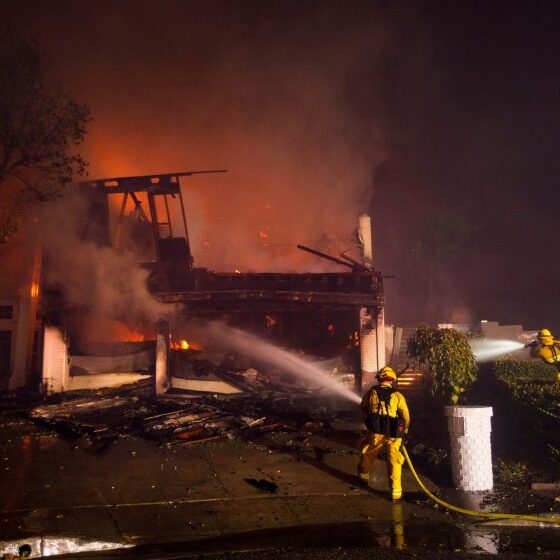Los Angeles Times Editorial: It’s about time California put the brakes on new housing developments in high-fire risk areas

(Patrick T. Fallon / For The Times)
One of the best ways to prevent wildfire destruction and death is to stop building houses in the likely path of the flames. Yet cities and counties across the state keep doing exactly that — approving sprawling new housing developments next to wildlands and marching property and people deeper into high-fire risk areas.
We know this development pattern is dangerous. Half of the buildings destroyed by wildfire in California over the last 30 years have been in developments on the urban fringe, next to wildlands (a type of geography that planners call the “wildland-urban interface”). For years, state leaders have wrung their hands over this contradiction, but demurred from taking action because local governments have control over land-use decisions.
Now, finally, someone in power has gotten off the sidelines. Among his final acts as state attorney general before becoming secretary of the U.S. Department of Health and Human Services, Xavier Becerra has gone to court to try to block housing developments approved in high-fire risk areas.
In February, Becerra joined a lawsuit challenging the Guenoc Valley Project, which would put 1,400 houses, hotels, restaurants and shops on Lake County hills that have been burned by wildfires a dozen times, most recently last year. Before the project was approved, Becerra’s office had sent letters to Lake County officials warning that the project’s design would exacerbate wildfire risk and hinder evacuations during a fire.
This month, Becerra joined lawsuits against two housing and resort developments in southwestern San Diego County, arguing authorities didn’t adequately analyze the risks of bulldozing untouched chaparral and scrubland and putting thousands of new residents in the fire-prone area. The Otay Ranch projects include 3,000 new homes, shopping centers, offices and parks.
The San Diego County Board of Supervisors approved the Otay Ranch projects with the support of local California Department of Forestry and Fire Protection officials, the San Diego Union-Tribune reported. The building industry, backed by fire officials, insists that building homes with hardy materials surrounded by fire-resistant landscaping will adequately protect communities in high-fire risk areas.
Experience and science disagree.
California’s wildfires have become more destructive and deadly over time. One reason is climate change, which amplifies natural variations in the weather, leading to more frequent, intense and destructive wildfires. Another reason is that we’re increasingly building projects in fire-prone terrain, as urban areas become too expensive or people move to be closer to nature.
More than a million homes were built in the urban-wildland interface between 1990 and 2010. One study found half of all buildings lost to fire during the last three decades were in this type of region. Many of these homes were built under modern codes, with fire-resistant materials and fuel breaks that are supposed to stop or slow fires. But some of the most deadly blazes have been wind-driven fires that blow embers across a landscape and can quickly overwhelm hardened construction. Stricter building codes and more fire engines cannot eliminate the dangers of living in high fire-risk areas.
Nobody’s calling for California to tear down existing homes in risky areas. Those properties and the surrounding communities should be retrofitted to become more fire resistant. But given the known danger, it’s folly to keep approving new, sprawling mini-cities that put future residents, workers and firefighters in harm’s way. Especially when California can build sustainably by making room for more homes by filling in less developed urban areas closer to jobs and transit.
That’s why Becerra’s intervention is both welcome and overdue. He was simply following the law — in 2018, the state updated the California Environmental Quality Act to require greater scrutiny of projects in the wildfire risk areas. Whoever takes over for Becerra as California’s next attorney general should keep up the pressure. Local elected officials need to know the state is watching and ready to challenge dangerous development decisions.

